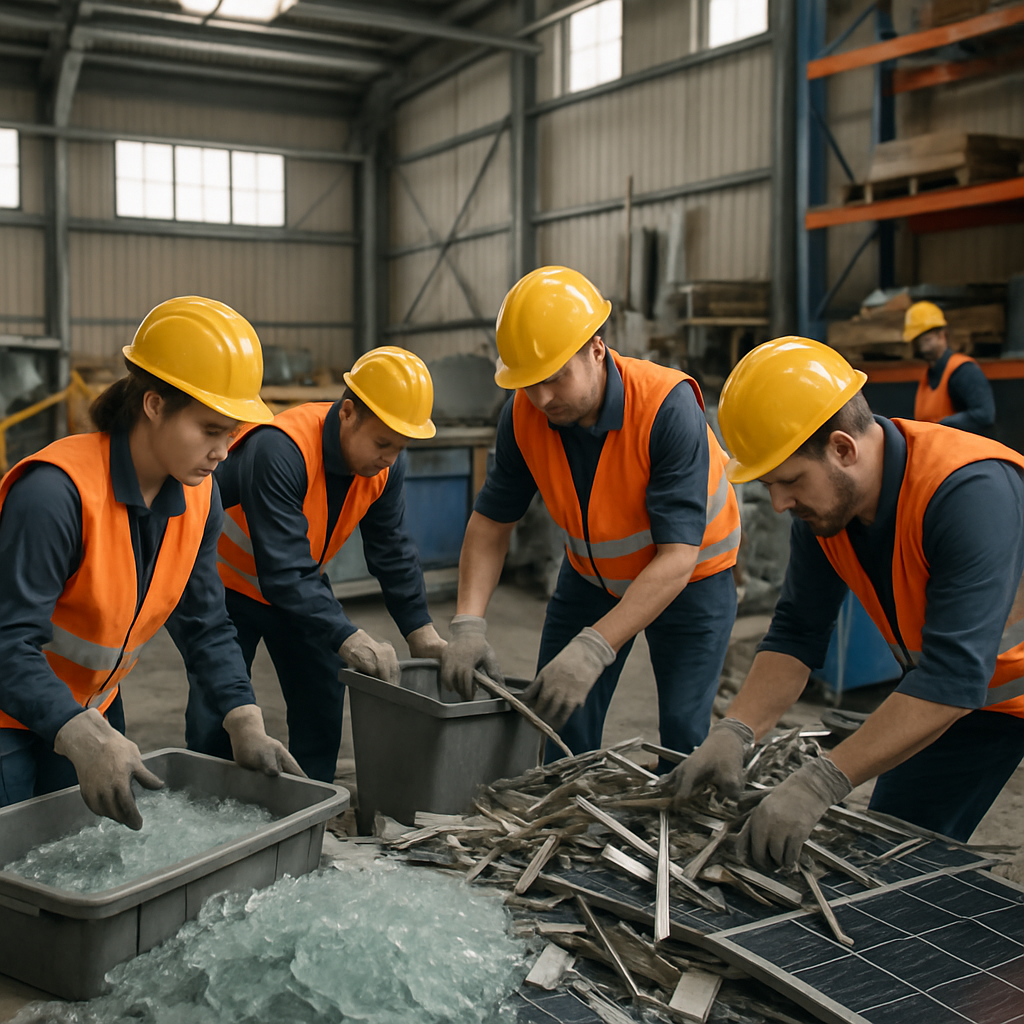5901 Botham Jean Blvd, Dallas, TX 75215
Exploring Why Cadmium Telluride (CdTe) Panel Recycling in Texas is Important
November 15, 2025Nearly 90% of solar panels currently end up in landfills when they reach the end of their operational life. This statistic is particularly concerning given the presence of cadmium telluride (CdTe) thin-film solar panels, which contain hazardous materials posing significant environmental risks if not managed properly. Texas, as a leading solar energy state, faces increasing pressure to address this growing waste responsibly.
Cadmium telluride panels are a type of thin-film solar technology containing toxic substances, including cadmium and telluride compounds. These hazardous materials can leach into soil and groundwater if panels are disposed of improperly in traditional landfills. With a 25 to 30-year lifespan, panels installed in Texas during the early solar boom are now reaching end-of-life status, creating an urgent need for proper e-waste management solutions.
Responsible CdTe panel recycling in Texas fulfills two critical objectives. It prevents environmental contamination by keeping toxic materials out of landfills and waterways, thereby protecting public health and ecosystems. Additionally, it supports resource conservation by recovering valuable materials like silver, copper, and tellurium for reuse in new products. The U.S. Environmental Protection Agency acknowledges that current recycling infrastructure in the glass, metals, and electronics industries can handle end-of-life electronics like solar panels, making environmental responsibility both achievable and economically viable.
What Does the Recycling Process for CdTe Panels Involve?
CdTe solar panel recycling requires specialized handling due to the presence of cadmium, a hazardous material that must be carefully managed during the dismantling process. Recycling begins with the collection and transportation of panels to certified facilities equipped to handle these materials safely.
The initial step involves mechanical processing, where panels are shredded into large pieces and then crushed in hammer mills into smaller fragments of about 4-5 millimeters. This reduction in size breaks the lamination bonds and exposes the cadmium telluride semiconductor layers for subsequent chemical treatment.
Component separation follows through a multi-stage approach. The film removal process uses rotating leach drums with sulfuric acid to dissolve the semiconductor materials. During this cycle, hydrogen peroxide is added to convert tellurium into tellurous acid, facilitating the extraction of valuable materials from the glass substrate.
Solid-liquid separation is a critical phase where spiral classifiers use Archimedean screws to separate glass pieces from the chemical solution. The glass fragments undergo further processing to remove remaining laminate materials through vibrating screens, resulting in clean glass cullet ready for recycling.
The final precipitation and dewatering stage involves a three-phase process using sodium hydroxide for pH control. This sets optimal conditions where cadmium and tellurium become least soluble, allowing for recovery as semiconductor-grade materials. The process typically recovers 90% of the glass content and 95% of the semiconductor materials.
Metal refining occurs throughout the process as copper from junction boxes and wiring systems is separated and prepared for secondary resource markets. The recovered materials provide valuable inputs for new manufacturing, supporting circular economy principles while ensuring hazardous materials remain safely contained within controlled industrial processes.
Special handling protocols govern every aspect of the recycling process, from initial dismantling to final material recovery. These procedures prevent environmental contamination while maximizing the recovery of secondary resources that can replace virgin materials in new solar panel production and other applications.
What Are the Main Benefits of Recycling Solar Panels?

The environmental advantages of solar panel recycling extend beyond simple waste diversion. Proper recycling prevents hazardous materials like lead, cadmium, and selenium from contaminating soil and groundwater. These toxic substances pose serious risks if panels end up in landfills, where they can leach into the environment over time.
Resource conservation is another significant benefit. The recovery of valuable materials creates both environmental and economic value. According to the International Renewable Energy Agency, recoverable raw materials from photovoltaic panels could yield up to $450 million by 2030, equating to materials for about 60 million new panels.
The recycling process achieves impressive material recovery rates. Modern facilities can recover up to 95% of semiconductor materials and 90% of glass from end-of-life panels. This includes minerals such as silicon, silver, and copper, essential for new solar technology and various industrial applications.
Environmental Protection Through Safe Disposal
Recycling each solar panel prevents approximately 97 pounds of carbon dioxide emissions compared to manufacturing new panels. This reduction becomes increasingly significant as solar installations reach their 25-30 year lifespan. The process also conserves landfill space and prevents the release of toxic substances into ecosystems.
Disposing of hazardous materials through certified recycling ensures compliance with environmental regulations. This approach protects water sources from contamination and maintains soil quality. A controlled processing environment allows safe handling of potentially dangerous components requiring specialized treatment.
Economic Benefits and Job Creation
Solar panel recycling generates employment opportunities across various sectors, including collection services, transportation logistics, disassembly operations, and materials processing. Large recycling facilities can process millions of panels annually, needing skilled technicians and operational staff.
Market projections indicate substantial growth potential for recycling. The global solar panel recycling market is expanding at a compound annual growth rate of 22.3%, with North America contributing about 46% of market value. This growth creates sustainable jobs and supports local economies.
Material recovery provides economic value through the resale of extracted components. Silver content alone can represent up to 47% of the reclaimed material value from each panel. Other valuable materials include aluminum frames, copper wiring, and high-purity silicon suitable for remanufacturing.
Circular Economy and Sustainability Benefits
Solar panel recycling supports circular economy principles by transforming waste into valuable resources. This approach reduces dependence on raw material extraction and minimizes mining’s environmental impact. Recovered materials can replace virgin resources in manufacturing.
The sustainability benefits extend to supply chain resilience. Domestic material recovery reduces reliance on imported components and decreases transportation emissions. This localized approach strengthens regional supply chains while supporting environmental conservation goals.
Long-term projections show the impact potential of comprehensive recycling programs. By 2050, recovered materials could provide for approximately 2 billion new panels without additional raw material mining, representing significant environmental and economic value for renewable energy.
Conclusion: Adopting Sustainable Solar Panel Management

Properly managing end-of-life Cadmium Telluride panels through recycling is crucial for the long-term sustainability of renewable energy. Professional recycling services in Texas ensure that hazardous materials are handled safely while valuable resources are recovered and waste is diverted from landfills. This responsible approach transforms potential pollutants into valuable commodities, supporting a circular economy that maximizes resource recovery and minimizes environmental impact.
As Texas continues to lead the nation in solar capacity, adopting sustainable practices for solar asset management becomes essential for businesses committed to environmental stewardship. To ensure your end-of-life solar panels receive proper recycling treatment that meets sustainability standards, contact Okon Recycling at 214-717-4083 for comprehensive recycling solutions.
